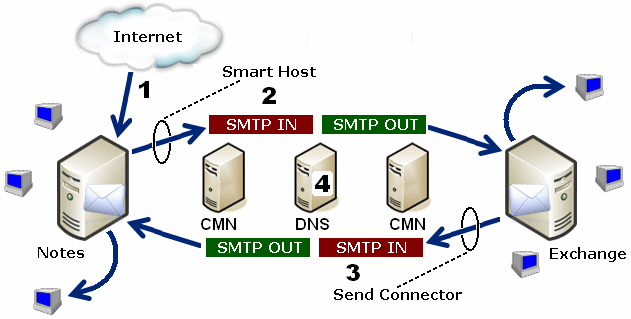Quest Coexistence Manager for Notes (CMN)
|
• |
Directory Connector: Updates directory data between the Domino Directory and Active Directory, configurable for any number of servers. |
|
• |
Mail Connector: Monitors SMTP traffic between Domino and Exchange to intercept and fix the incompatibilities inherent to certain message types and message contents and attachments. This email remediation service detects and converts in-transit messages as necessary, on the fly, to facilitate cross-platform functionality of most calendar functions, message attachments, and Notes rich-content mail features whereby messages can carry "live" or "active" functional content. |
|
• |
Free/Busy Connector: Facilitates the exchange of calendar free/busy data between users in the two different environments. This sharing of free/busy data between Notes and Exchange makes possible automatic calendar updates for accepted meeting invitations, or when a user proposes a different day/time, or cancels, etc. |
SMTP email routing
Mail routing by SMTP addressing within a single domain is accomplished using smart hosts in both directions. Exchange can be configured to route mail to a smart host if Exchange determines the recipient is not in the local internet domain. Exchange routes such mail to the smart host, via the targetAddress attribute in the Active Directory object record. Meanwhile, Domino is configured to do the same thing in reverse for a recipient whose local internet domain address is not listed in any Domino person documents.
To configure smart-host SMTP routing with Quest's CMN, both smart hosts are configured to point to the CMN server. Within CMN, one set of SMTP IN and SMTP OUT queues is configured to accept mail from Domino and deliver it to the receiving Exchange server, while another set is configured to accept mail from Exchange and deliver it to Domino. Multiple CMN servers can be deployed for load balancing and redundancy. The CMN User Guide explains this scenario in more detail (see Coexistence Mail Routing Basics in chapter 3). And see also your Domino and Exchange documentation and online resources for more information about configuring smart hosts for those servers.
For example, if your original domain is domain.com, then assign a new notes.domain.com subdomain to the Domino server, and assign a new exch.domain.com subdomain to the Exchange server. Then, when internal mail from other Notes users arrives in the Notes accounts of already-migrated users, the mail can be forwarded to the appropriate Exchange mailboxes using the exch.domain.com subdomain.
A subdomain routing method may introduce a risk that the assigned subdomain names will escape your organization’s internal communications, which in turn can cause bounce-backs on replies to those addresses. To prevent this, set the Notes forwarding address attribute to user@subdomain@notesdomain, which causes Domino to set the reply address for external email to the user's primary SMTP address (internet address field value).
About Notes 8.5 Compatibility Mode
Beginning with Lotus Notes version 8.5, IBM offers a configuration called Compatibility Mode to streamline iCalendar interoperability with other mail systems. This is accomplished by limiting the functionality within the Notes calendar to those functions that will be seamlessly supported by other mail systems. Some have wondered if Notes' Compatibility Mode might be a reasonable alternative to Quest’s CMN for calendar coexistence.
If you would like to see a more detailed comparison, please contact your Quest Sales representative.
Directory updates
If updates of coexisting directories is not a high priority, you may simply add and delete users and update user data in the Exchange environment (only), using Exchange administration software. Otherwise, if it is important to keep the two directories coordinated throughout the transition period, you can do that and also update the SQL Server database, as described in Appendix A of the Migrator for Notes to Exchange Administration Guide (see How Do I Update Directory Data and Update the SQL Server Database?).


